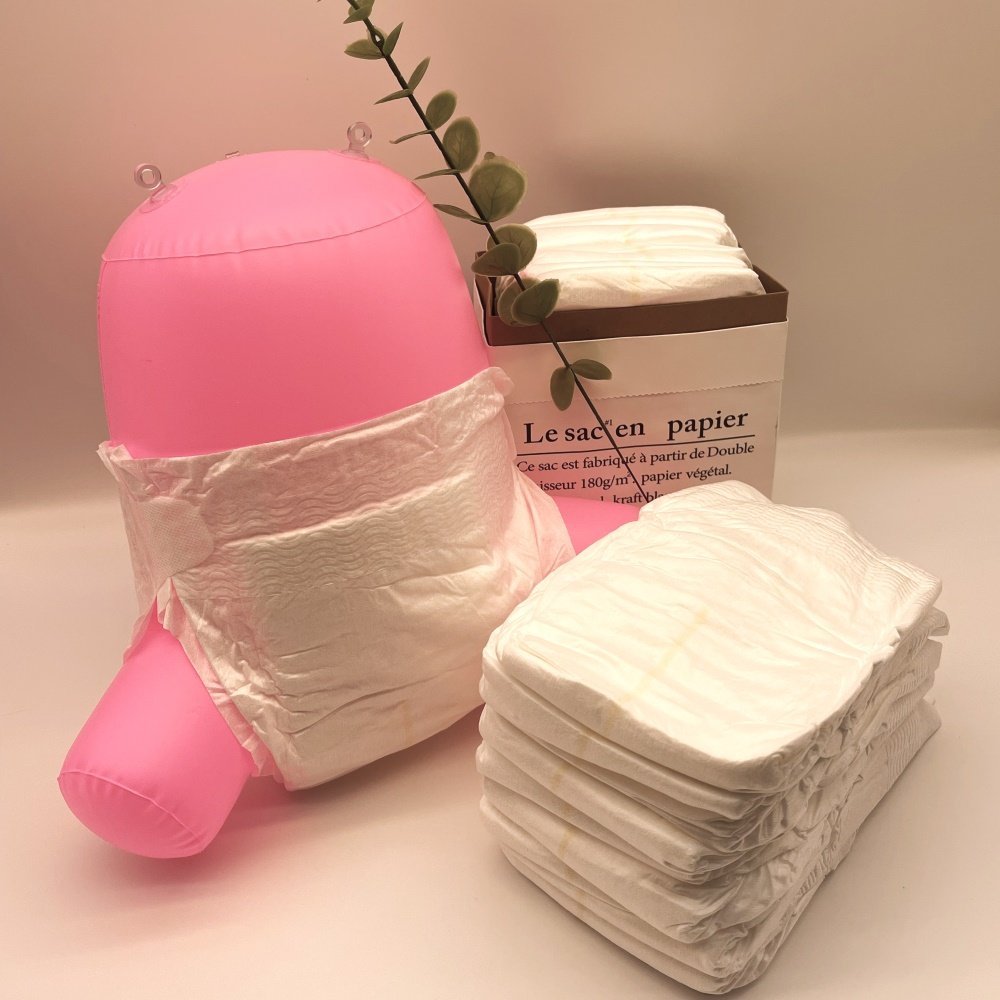When it comes to parenting, choosing between pull-ups and diapers is more than just a matter of preference; it’s about understanding what works best for your child at different stages of their development. Pull-ups, often seen as the next step for toddlers who are on the path to potty training, offer the convenience of easy up and down, resembling underwear. Diapers, on the other hand, are the go-to for newborns and infants, providing secure, absorbent protection against leaks.
Both options have advantages and challenges. While diapers are known for their high absorbency and are ideal for overnight use, pull-ups promote independence. They are easier for children to remove themselves, aiding in the potty-training process. This article delves into the nuances of pull-ups and diapers, comparing their features, costs, and environmental impacts to help you make the best choice for your child’s needs.
جدول المحتويات
The Evolution of Baby Hygiene Products
The journey from cloth wraps to modern disposable diapers and pull-ups is a testament to the advancements in child care and hygiene. Initially, parents relied on cloth diapers, which were economical but labor-intensive due to washing requirements. The invention of disposable diapers in the 20th century revolutionized baby care, offering convenience and improved hygiene. Pull-ups entered the market later, addressing the need for an intermediate solution that supports the potty-training process by allowing toddlers more independence and the ability to dress and undress themselves.
Analyzing the Features: Pull-Ups
Pull-ups are designed as a transitional garment between diapers and regular underwear. They have elastic waistbands that make them easy to pull up and down, fostering a sense of independence in toddlers. This feature is particularly beneficial during potty training, as it encourages children to learn about their bodily cues and manage their bathroom needs with more autonomy. Furthermore, many pull-ups are designed with fade-when-wet patterns to help both parents and children know when it’s time for a change.
Exploring the Features: Diapers
Diapers, on the other hand, are a staple of infant and early toddler care. They are known for their high absorbency and leak-proof designs. They are constructed with layers of material that lock moisture away, keeping the skin dry and preventing rash. Diapers are available in various sizes and styles, including those specifically designed for overnight use, with extra absorbency to ensure a good night’s sleep for both baby and parents.
Pull-Ups vs Diapers: Usage and Application
Deciding between pull-ups and diapers often comes down to the specific needs and activities of the child. During the day, especially for active toddlers, pull-ups are advantageous because they can be easily pulled down for quick potty breaks, fostering independence and self-awareness. For infants and during nighttime, diapers are preferable due to their higher absorbency and ability to contain leaks, ensuring a comfortable sleep.
Transitioning from diapers to pull-ups is a significant milestone in a child’s development. It usually aligns with the start of potty training, indicating that the child is becoming more aware of their need to use the bathroom. Parents might consider switching to pull-ups when their child shows signs of readiness, such as expressing discomfort with wet diapers, showing interest in using the toilet or being able to pull pants up and down independently.
Parental Insights: Comfort and Fit
Comfort and fit are paramount when choosing between pull-ups and diapers. Parents often favor the option that keeps their child dry, comfortable, and rash-free. Pull-ups with soft, stretchy sides and diapers with flexible waistbands and leg openings are popular for their snug yet comfortable fit, which minimizes leaks and prevents skin irritation.
Feedback from parents highlights the importance of selecting a product that adapts to the child’s movements without causing chafing or leaks. Children with sensitive skin might require hypoallergenic options, which are available in both diapers and pull-ups. Parental experiences also stress the significance of trial and error in finding the perfect fit and material for their child’s specific needs.
Economic Considerations: Cost Analysis
The cost of pull-ups and diapers is a crucial factor for many families. Diapers are generally less expensive per unit than pull-ups, but the total cost can depend on factors like the child’s age, the rate of potty training progression, and the frequency of changes. Bulk purchasing can offer savings, though it’s important to balance this with the child’s changing sizes and needs.
The goal is to transition fully to underwear long-term, making pull-ups a temporary expense. However, the duration of this phase can vary significantly, influencing the overall cost. Parents should consider both the immediate and long-term financial implications of their choice, weighing the benefits of each product’s convenience and effectiveness against its price.
Environmental Impact: Sustainability and Disposal
The environmental footprint of pull-ups and diapers is a growing concern for eco-conscious parents. Traditional disposable diapers and pull-ups contribute significantly to landfill waste, as they are predominantly made from non-biodegradable materials. However, the market has responded with eco-friendly options made from sustainable, biodegradable materials that minimize environmental impact.
When considering the environmental aspect, it’s important to look at the entire lifecycle of the products, from production to disposal. Some parents opt for cloth diapers as a more sustainable alternative, though this choice comes with its own set of challenges, including increased water and energy use for laundering. Biodegradable pull-ups and diapers, while more expensive, offer a compromise, reducing the environmental impact while maintaining the convenience of disposables.
Expert Opinions: Pediatric and Childcare Advice
Pediatricians and childcare experts often weigh in on the pull-ups versus diapers debate, focusing on the developmental and health aspects. Experts suggest that the choice should be guided by the child’s readiness for potty training, their comfort, and the parents’ convenience and lifestyle.
Health professionals emphasize that pull-ups can be beneficial for children who are showing signs of readiness for toilet training, as they mimic real underwear and can encourage independence. However, they caution against early or forced transition, which can lead to frustration and setbacks in the training process. Diapers are recommended for younger children and babies, as they provide the necessary absorbency and protection, especially during the early stages of development.
Real-life Experiences: Stories from Parents
Parental anecdotes provide valuable insights into the practical aspects of choosing between pull-ups and diapers. Stories from the parenting community often highlight the convenience of pull-ups for daytime use and during outings, where quick changes are necessary. Conversely, many parents rely on the absorbency and reliability of diapers for overnight use, especially for children who are heavy wetters.
Some parents share their experiences with potty training, noting that pull-ups can serve as a motivational tool for children who are excited about the prospect of wearing “big kid” underwear. Others find that their children may become too comfortable in pull-ups, leading to a delay in potty training progress. These real-life stories underline the importance of aligning the choice of product with the child’s individual needs and the family’s routines.
Pull-Ups vs Diapers: Decision-making Factors
Choosing between pull-ups and diapers involves considering several factors that impact a child’s comfort, health, and overall family lifestyle. The decision often hinges on the child’s stage in development, particularly concerning potty training readiness and nighttime control.
Pull-ups are generally favored for children who are in the transitional phase, showing signs of readiness for potty training but still needing protection for occasional accidents. They offer the advantage of being more like underwear, which can help children feel more grown-up and encourage them to use the toilet. However, some children may see pull-ups as just another type of diaper, potentially prolonging the potty training process.
Diapers, conversely, are indispensable for newborns and young infants, providing the necessary absorbency and protection. Due to their superior leak protection, they are also often preferred for overnight use, even with older toddlers.
Pros and Cons Summary
Pull-Ups:
Pros:
- Encourage independence and self-training in potty-trained toddlers.
- Easier for children to pull up and down, facilitating the learning process.
- Often have training features like cooling sensations or designs that fade when wet.
Cons:
- They are more expensive than diapers.
- It may not be as absorbent as diapers, leading to potential leaks.
- It can delay potty training if used too early or when the child is not ready.
Diapers:
Pros:
- Higher absorbency, providing better leak protection, especially overnight.
- Generally cheaper per unit than pull-ups.
- Come in a wider range of sizes, fitting very young infants to larger toddlers.
Cons:
- Less conducive to potty training, as they don’t encourage independence.
- It can be more challenging for older children to change themselves.
In conclusion, the choice between pull-ups and diapers is contingent upon the individual needs of the child and the family’s preferences. Parents should consider factors like age, potty training readiness, overnight protection needs, and cost when making their decision.
Conclusion: Making the Best Choice for Your Child
Deciding whether pull-ups or diapers are best for your child is a nuanced choice that reflects your child’s developmental stage, your family’s lifestyle, and your preferences. While pull-ups can facilitate the transition to full potty training, diapers may be the practical choice for younger children and for overnight use. The key is to observe your child’s readiness and comfort and to choose the option that effectively supports their growth and learning process.
Ultimately, whether you lean towards pull-ups or diapers, remember that each child’s journey is unique, and what works best for one may not suit another. Being flexible and responsive to your child’s needs will guide you to the best choice, ensuring comfort, convenience, and confidence in this important stage of your child’s development.
FAQs
What is the right age to switch from diapers to pull-ups?
The transition from diapers to pull-ups varies depending on each child’s development. Typically, parents might consider introducing pull-ups when their child shows signs of readiness for potty training, such as expressing discomfort with wet or dirty diapers, showing interest in the toilet, or being able to pull pants up and down. This can happen anywhere from 18 months to 3 years of age.
Can pull-ups hinder potty training?
Pull-ups can be a double-edged sword in potty training. While they can promote independence by allowing children to pull them up and down, they might also delay the process if children become too reliant on them. It’s crucial to use pull-ups as a transitional tool, encouraging your child to use the toilet and gradually move towards regular underwear.
Are diapers or pull-ups better for nighttime?
Diapers are typically more absorbent and offer better protection against leaks, making them ideal for nighttime use, especially for younger children and heavy wetters. However, for older toddlers who are mostly potty trained but might still have occasional accidents, pull-ups can be a good nighttime option.
How can I make the transition to pull-ups easier for my child?
Making the transition smoother involves several strategies, such as letting your child choose their own pull-ups, explaining how they are different from diapers, and encouraging regular toilet breaks. Positive reinforcement and consistency in routine can also play significant roles in easing the transition.
Do pull-ups work as well as diapers for preventing leaks?
Pull-ups are designed to be less bulky and more like underwear, so they might not have the same level of absorbency as diapers. They are effective for children who have begun potty training and have fewer accidents. Still, diapers are generally more reliable for preventing leaks, particularly for younger children and during the night.
Are there eco-friendly options for pull-ups and diapers?
Yes, eco-friendly options are available for both pull-ups and diapers. These products are made from sustainable materials, are often biodegradable, and have a lower environmental impact. They can be more expensive than traditional options, but they offer an alternative for environmentally conscious parents.

